Introduction
Sesame Soba Noodles: A Global Slurp of Comfort from My Kitchen to Yours
It started with a question in a steamy Tokyo ramen shop: “What do noodles mean to you?” The answer came not in words, but in a quiet bowl of soba—nutty, chilled, drizzled with sesame, and alive with umami.
Hi, I’m Olivia, your noodle guide for life. From my grandmother’s Roman kitchen to the far corners of Asia, noodles have been my language of comfort, curiosity, and connection. And among them, soba—those slender buckwheat strands—holds a special place.
These Sesame Soba Noodles aren’t just a quick weeknight meal (though yes, they’re ready in 20 minutes flat). They’re a passport to flavor: cool and earthy, kissed with toasted sesame oil, brightened with rice vinegar, and perfect either solo or topped with crunchy veggies or grilled protein.
If you’re new to the noodle world or want to explore more, check out this guide on noodle types and varieties or dive into the homemade noodle recipe basics to appreciate the craft behind every strand.
This isn’t just a recipe. It’s a story in a bowl. One you can eat warm or cold, on a Tuesday or for a dinner party, slurped joyfully with chopsticks or fork. (Need help with those? Here’s a handy chopsticks how-to.)
Ready to make it yours?
Why This Recipe Works
There’s a reason Sesame Soba Noodles have stood the test of time—this simple yet flavorful dish blends speed, nutrition, and versatility all in one satisfying bowl.
Quick and Easy
Sesame Soba Noodles are ready in under 20 minutes, making them ideal for weeknights or when time is short. A few pantry staples turn into something crave-worthy in minutes. For more quick ideas, try these 3-ingredient noodle recipes.
Healthy and Nourishing
Made with buckwheat, Sesame Soba Noodles are naturally high in fiber and protein. They’re gluten-free-friendly when you choose 100% buckwheat noodles. If you’re exploring other healthy options, check out my gluten-free pasta or keto-friendly noodle recipes.
Versatile and Customizable
This recipe welcomes creativity. Add steamed broccoli, shredded cabbage, tofu, shrimp, or whatever’s in your fridge. For more flexible bowl-building inspiration, visit my vegan noodle recipe collection.
Rooted in Culture, Made for Today
Soba is steeped in Japanese tradition, but this sesame dressing brings it to the modern table with ease. It’s a balance of heritage and everyday cooking—much like the global evolution explored in how noodles conquered the world.
Part of a Bigger Noodle Story
More than just a meal, Sesame Soba Noodles are part of the noodle journey I share across this site—from homemade classics to modern, mindful meals.
Ingredients and What You’ll Need
Core Ingredients
- Soba noodles – Buckwheat-based, nutty, quick-cooking. (Learn more about noodle types)
- Toasted sesame oil – Deep, nutty flavor essential to the dish
- Soy sauce or tamari – Adds umami depth; use tamari for a gluten-free option.
- Rice vinegar – Light acidity to brighten
- Honey or maple syrup – Adds optional sweetness to balance flavors.
- Garlic & ginger – Fresh, aromatic, and warming
Toppings & Add-ins
- Scallions – Crisp and fresh
- Sesame seeds – Toasted for extra depth
- Optional: shredded carrots, cucumber, tofu, edamame, chili flakes
Want a homemade base? Try homemade noodles or go wheat-based with Chinese egg noodles.
Step-by-Step Method
1. Cook the Soba Noodles
Bring a pot of water to a boil (no salt needed). Add soba noodles and cook according to package directions—usually 4 to 5 minutes. Stir occasionally to prevent sticking.
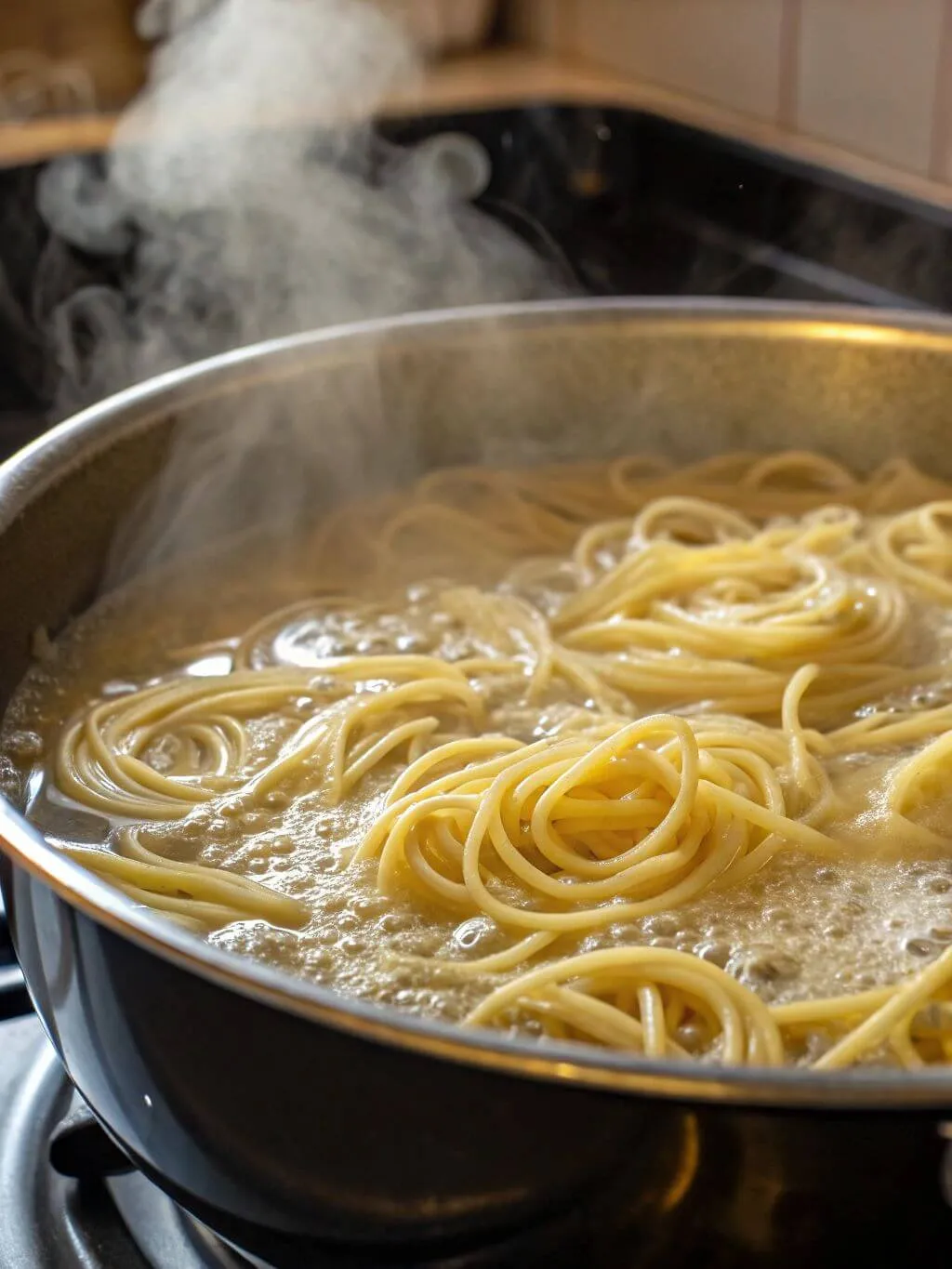
Pro tip: Soba can get gummy if overcooked. Drain and rinse under cold water to stop the cooking and remove excess starch.
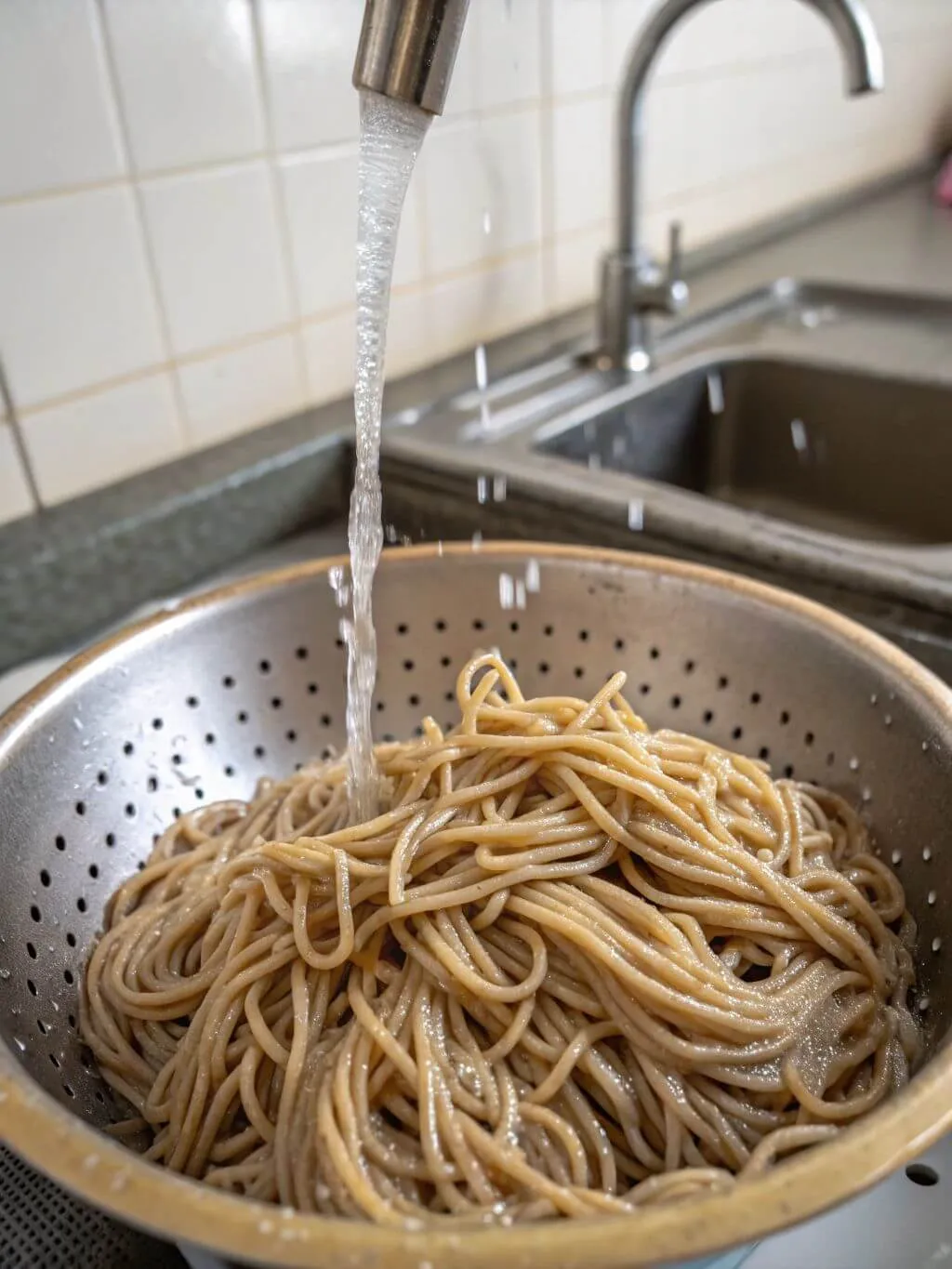
(Explore more on how buckwheat soba is made if you’re curious.)
2. Make the Sesame Dressing
In a bowl, whisk together:
- 2 tablespoons toasted sesame oil
- 2 tablespoons soy sauce or tamari
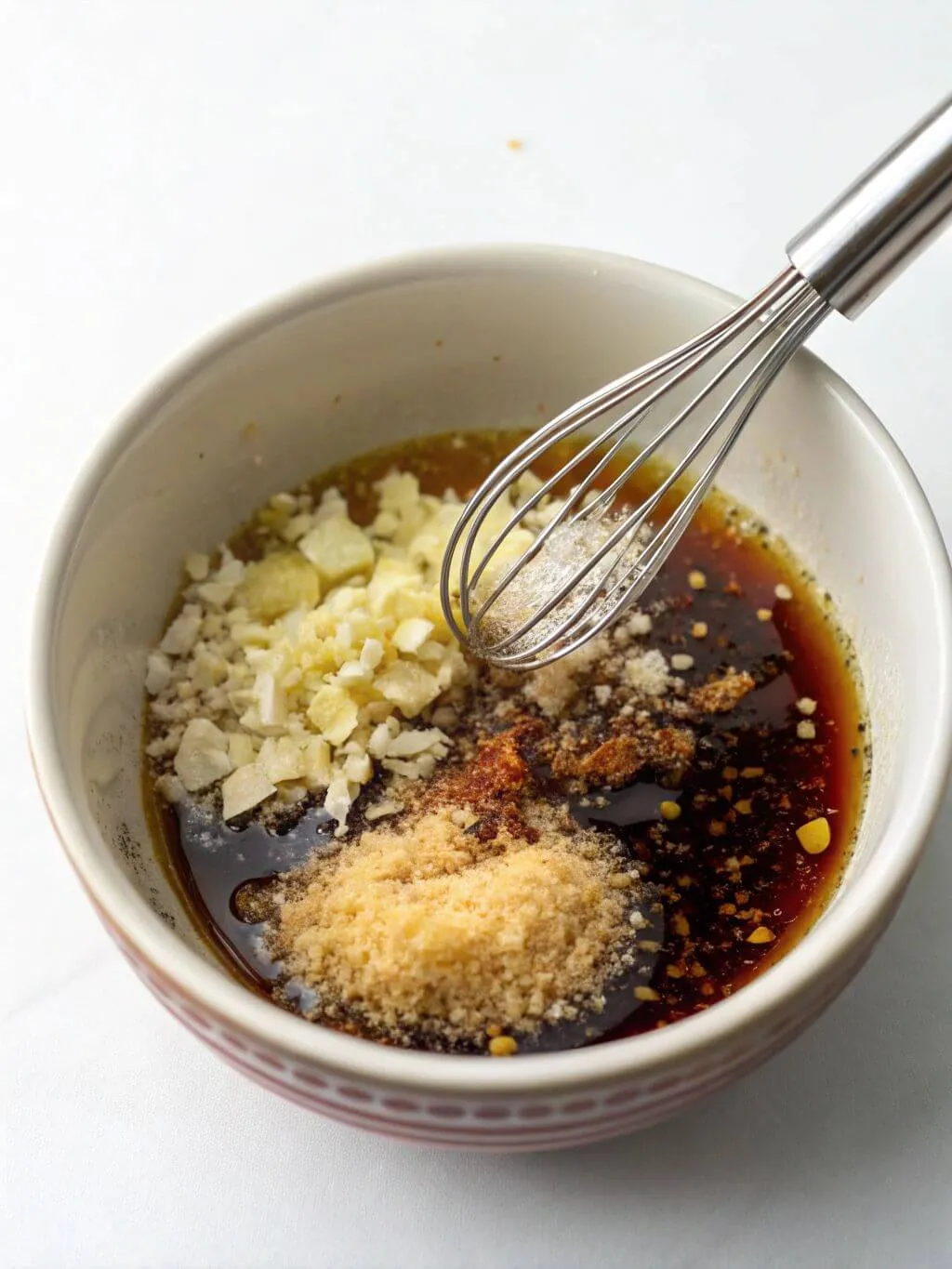
- 1 tablespoon rice vinegar
- 1 teaspoon honey or maple syrup
- 1 clove garlic, grated
- ½ teaspoon fresh ginger, grated
Adjust to taste—soy for salt, vinegar for tang, sweetener for balance.
3. Toss and Combine
In a large mixing bowl, add the rinsed soba noodles. Add dressing and toss to coat.
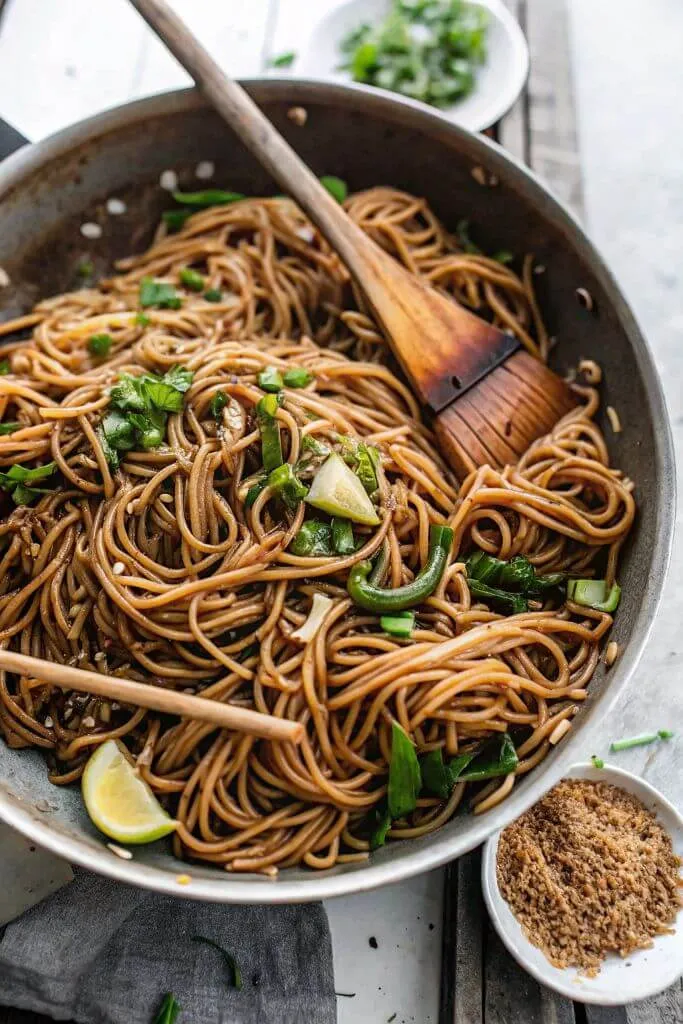
Top with sliced scallions, sesame seeds, and optional add-ins like carrots, tofu, cucumber, or chili flakes. Serve chilled or at room temperature.
Need chopsticks practice? Try this chopsticks how-to guide.
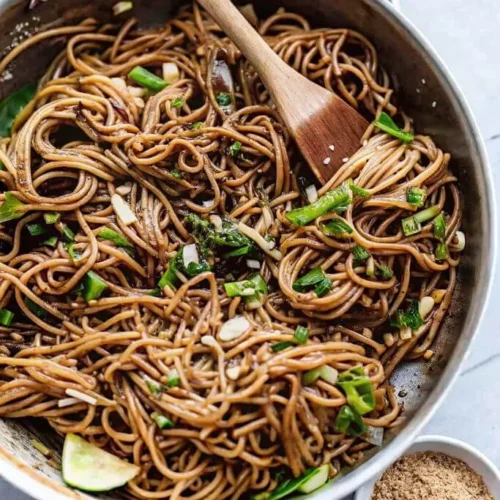
Sesame Soba Noodles
Ingredients
- 6 oz buckwheat soba noodles
- 2 tablespoons toasted sesame oil
- 2 tablespoons soy sauce or tamari
- 1 tablespoon rice vinegar
- 1 teaspoon honey or maple syrup (optional)
- 1 clove garlic, grated
- ½ teaspoon fresh ginger, grated
- 2 scallions, thinly sliced
- 1 tablespoon sesame seeds (toasted preferred)
- Optional (Shredded carrots, cucumber, red cabbage)
- Optional (Tofu, grilled chicken, shrimp)
- Optional (Chili crisp, crushed peanuts)
Instructions
- Cook the soba noodles: Boil water and cook noodles according to package directions (4–5 minutes). Stir gently and don’t overcook.
- Rinse thoroughly: Drain and rinse noodles under cold water to stop the cooking and remove starch.
- Make the dressing: In a small bowl, whisk together sesame oil, soy sauce, rice vinegar, honey/maple, garlic, and ginger.
- Combine: Toss noodles with the dressing in a large bowl. Add scallions, sesame seeds, and any desired toppings.
- Serve: Enjoy cold or at room temperature.
Nutrition
Serving and Pairing Suggestions
Sesame Soba Noodles are incredibly versatile and can be served in a variety of ways depending on the occasion or season.
Serve Them Cold or Warm
Chilled for summer or slightly warm for cooler months—both versions are equally delicious. Just be sure the noodles are well-rinsed to avoid stickiness.
Make It a Main or a Side
- As a main: Add grilled tofu, shrimp, or a jammy egg
- Great with miso soup, dumplings, or crisp slaw.
Great with Bold Veggies
Try adding:
- Shredded carrots or purple cabbage for crunch
- Blanched broccoli or snow peas for a green boost
- Quick-pickled cucumbers for brightness
Need ideas to build a full noodle spread? Browse through my vegan noodle recipes or try your hand at homemade Chinese egg noodles for variety.
Lunch or Meal Prep Friendly
Sesame Soba Noodles store well in the fridge and taste great the next day. Just toss with a splash of sesame oil to refresh before serving.
Looking for low-carb guests or meal prep alternatives? Offer a batch of keto-friendly noodles alongside.
Pro Tips for Success
Don’t Overcook the Noodles
Buckwheat soba cooks fast—usually in 4 to 5 minutes. Overcooking can lead to mushy noodles. Stir during cooking and check early.
Rinse Immediately
After draining, rinse soba under cold running water. This removes excess starch and keeps the noodles from clumping. It’s a small step that makes a big difference.
Use Toasted Sesame Oil
For maximum flavor, use toasted sesame oil—not regular. It adds a deep, nutty aroma that defines Sesame Soba Noodles.
Customize by Season
Serve warm in winter with sautéed mushrooms or cold in summer with crunchy veggies like cucumber and carrot. These noodle varieties offer even more inspiration for seasonal swaps.
Make it a Meal
Add protein like tofu, grilled chicken, or shrimp to turn these Sesame Soba Noodles into a more filling dish. For low-carb guests, offer a side of keto-friendly noodles as an alternative.
Prep Ahead
You can make the sesame dressing up to 3 days ahead. Store it in a sealed jar in the fridge and shake well before tossing.
Frequently Asked Questions About Sesame Soba Noodles
How do you cook buckwheat soba noodles?
Bring a pot of water to a boil and add soba noodles—no salt needed. Cook for 4 to 5 minutes, stirring occasionally to prevent sticking. Once tender, immediately drain and rinse under cold water to stop the cooking and remove surface starch. This prevents your Sesame Soba Noodles from becoming gummy.
Want to learn how different cultures prepare noodles? Check out this guide on homemade noodles.
Are buckwheat soba noodles healthy?
Yes. Buckwheat soba noodles are rich in protein, fiber, and essential minerals like manganese and magnesium. They’re naturally gluten-free if made from 100% buckwheat, making them a smart base for dishes like Sesame Soba Noodles. For other healthy pasta options, see gluten-free noodles and keto-friendly recipes.
Are soba and buckwheat noodles the same?
Not always. “Soba” typically refers to Japanese noodles made with buckwheat flour, but some brands mix in wheat flour for texture and elasticity. Always read the label if you’re avoiding gluten. For traditionalists, 100% buckwheat soba gives Sesame Soba Noodles their signature earthy flavor.
Curious about how noodles differ globally? Explore my deep dive on noodle types and varieties.
What pairs well with soba noodles?
Sesame Soba Noodles go beautifully with:
Protein: grilled chicken, shrimp, tofu, soft-boiled egg
Veggies: cucumber, shredded carrots, red cabbage, scallions
Extras: chili oil, peanuts, sesame seeds
Looking to level up your plating? Here’s a fun guide on how to eat with chopsticks.
Explore More Noodle Goodness
If you loved these Sesame Soba Noodles, there’s a whole world of slurp-worthy recipes and resources waiting for you. Whether you’re into DIY pasta making, exploring noodle culture, or tailoring meals to your lifestyle, these links have you covered:
Dive Deeper Into Noodle Knowledge
- Noodle Types and Varieties – Discover the global landscape of noodles, from Italian classics to Asian staples
- How Noodles Conquered the World – A deep dive into noodle history and global influence
Make Your Own
- Homemade Noodles Recipe – The foundational recipe for fresh pasta at home
- Homemade Chinese Egg Noodles – Perfect for stir-fries and soups
- Homemade Gluten-Free Pasta – Ideal for dietary needs without sacrificing flavor
Specialized Diet Recipes
- Keto-Friendly Noodles Recipe – Low-carb options that still feel indulgent
- Vegan Pasta Noodles Recipe – Plant-based pasta that satisfies
Noodle Etiquette and Culture
- How to Eat with Chopsticks – A beginner’s guide to mastering the art of chopsticks
Bookmark this section or explore one link at a time—your noodle journey has just begun.

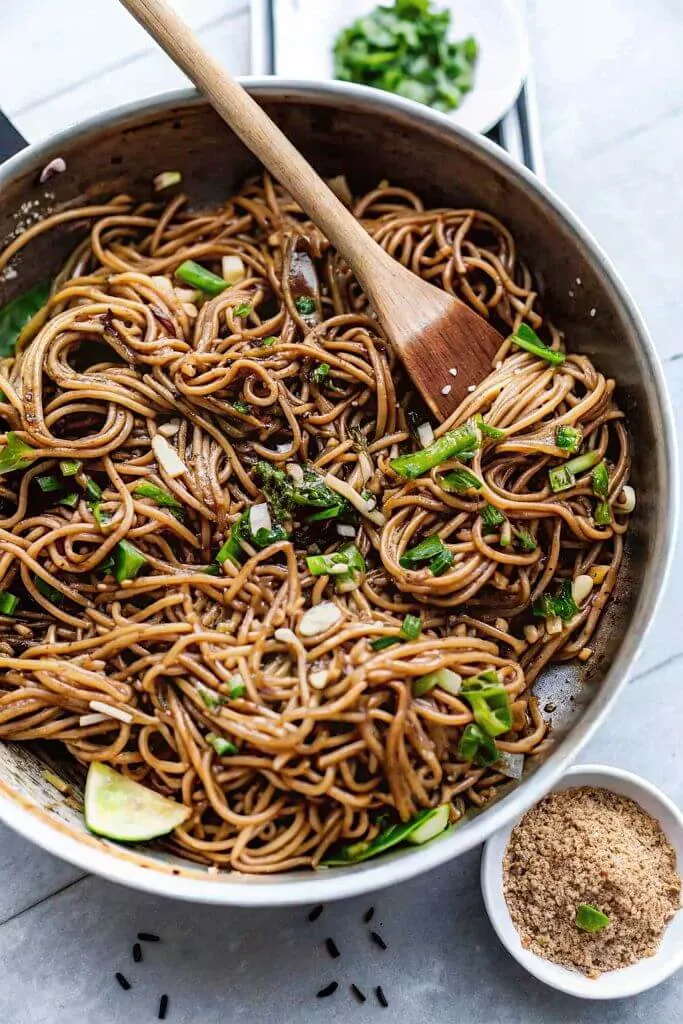
1 thought on “Sesame Soba Noodles (Quick & Easy 15-Minute Meal)”